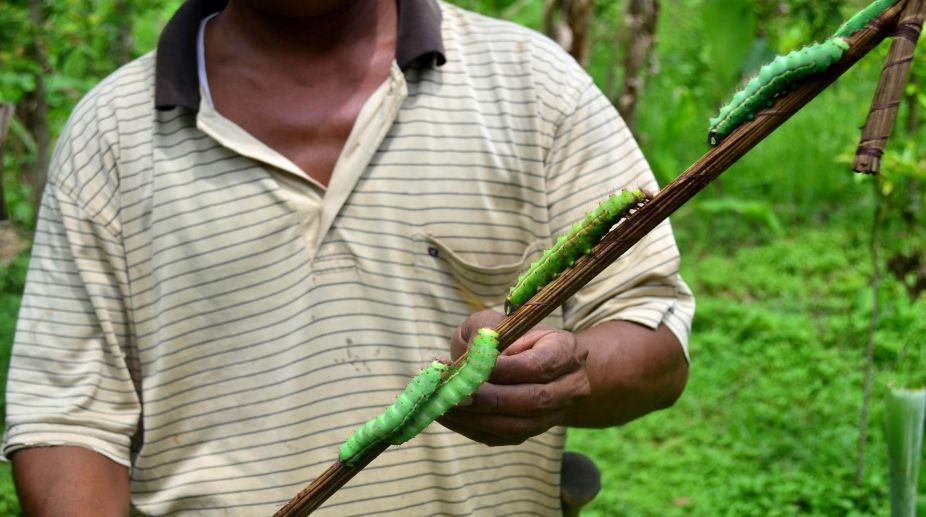Assam Monitors Odisha Train Derailment, CM Assures Aid
Assam Chief Minister Himanta Biswa Sarma on Sunday said that his administration is actively monitoring the train derailment involving the SMVT Bengaluru-Kamakhya AC Express in Odisha's Cuttack.

(Photo: IANS)
A "snapshot" of the muga silkworm genome decoded by Indian scientists offers vital clues for imparting disease-resistance to help conserve the economically important insect which spins the distinctive golden yellow fabric synonymous with Assam.
Bioengineering Research Laboratory (BERL) at IIT-Guwahati, in collaboration with the Central Silk Board (CSB) has, for the first time, dug inside the transcriptome-genetic blueprints that are needed to translate the information stored in the DNA into functional gene products such as proteins.
Advertisement
In the muga silkworm's case, components that shield it against diseases and provide immunity, were deciphered.
Advertisement
"We have for the first time decoded the comprehensive transcriptome of muga silkworm using next-generation sequencing. Information obtained by transcriptomic studies along with full genome sequence will help draw research strategies for protection of muga silkworm from the vagaries of nature," Utpal Bora, team leader at BERL, told IANS about the latest study.
Transcriptomes (collection of messenger RNA molecules in a tissue or cell) are indicative of gene activity and can vary with external environmental conditions.
So, analysing transcriptome provides an idea about how environmental factors drive gene activity and influence immunity in the silkworm.
"Once the full molecular information is decoded, advanced technologies like 'genome editing' and 'genome engineering' can help immensely in conservation and development of new muga silkworm varieties in future," Bora said.
A. assamensis, popularly known as the muga silkworm, is the most important component of the Assamese silk industry and it hugely contributes towards employment generation in northeastern India, having great socio-economic and cultural significance for several tribes and communities of the region.
Around 60,000 families are engaged in the muga silk industry in Assam. A little amount of muga silk is also produced in Meghalaya, Arunachal Pradesh, Manipur, Mizoram and Nagaland.
It is also a source for novel biomaterials that have applications in skincare, tissue engineering and the like.
Despite acquisition of a Geographical Indication tag, this silkworm and the associated industry remains vulnerable.
For one, the insect's habitat preferences are restricted to northeast India, adding to its vulnerability.
"In addition, widespread use of pesticides in tea gardens, jhum cultivation and deforestation threaten its survivability. With global warming, increased urbanisation and lack of awareness among youths with respect to sericulture as a profession, the scenario is very discouraging for the muga-culture in the region," said Hasnahana Chetia, a research scholar and lead author of the study.
Disease and pest infestation also ravage the rearing of the seed crop (silkworm eggs). It is subjected to viral, bacterial, fungal and protozoan diseases that result in heavy crop losses up to 40 per cent for individual diseases.
Chetia also pointed to the fact that governments across the world have invested heavily during the last two decades and scientists have doggedly led studies to understand and experimentally engineer the genetic make-up of the mulberry silkworm.
However, very little has been done for conservation of the muga variety of Assam, she lamented.
As early as 1900, Japan had initiated research on the mulberry silkworm (Bombyx mori).
Recently, Chinese scientists claimed to have found a way to turn silkworms into virus killers, a technology they say will not only increase worldwide silk production but can also fight human viruses such as HIV.
In fact, mulberry silkworm is one of the most researched insects after fruit flies and has contributed to developments and discoveries in other disciplines as well, said study co-author Deepika Singh.
According to P. Jayaprakash, former Director of the National Silkworm Seed Organisation (under CSB), only two per cent of the total silk produced in the country is of the muga variety.
The northeastern states generate about 170 tonnes of muga annually, he said.
"Though they are all northeastern states, the microclimate differs. There is a gulf between production and productivity. I hope within a few years the scientists will supply disease-resistant worms, so we can produce muga in different seasons and different zones. The target is 200 tonnes for 2016-2017. In the days to come there is scope for enhancing production because this is the beginning of a study," Jayaprakash told IANS.
"The construction of a transcriptome database is under way at our laboratory to facilitate better dissemination and usage of the information generated in this study," added co-researcher Debajyoti Kabiraj.
Ponnala Vimal Mosahari, Suradip Das, Pragya Sharma, Kartik Neog, Swagata Sharma and P. Jayaprakash are the other authors of the study, published in February in the Gene journal.
Advertisement
Assam Chief Minister Himanta Biswa Sarma on Sunday said that his administration is actively monitoring the train derailment involving the SMVT Bengaluru-Kamakhya AC Express in Odisha's Cuttack.
Senior journalist Dilwar Hussain Mozumder, Chief Reporter of the digital news portal The Crosscurrent, walked free from Guwahati Central Jail on Saturday after securing bail in the second case against him.
Assam Chief Minister Himanta Biswa Sarma has announced a reduction of Rs 1 per unit in electricity tariffs in the state, effective from April 1.
Advertisement
